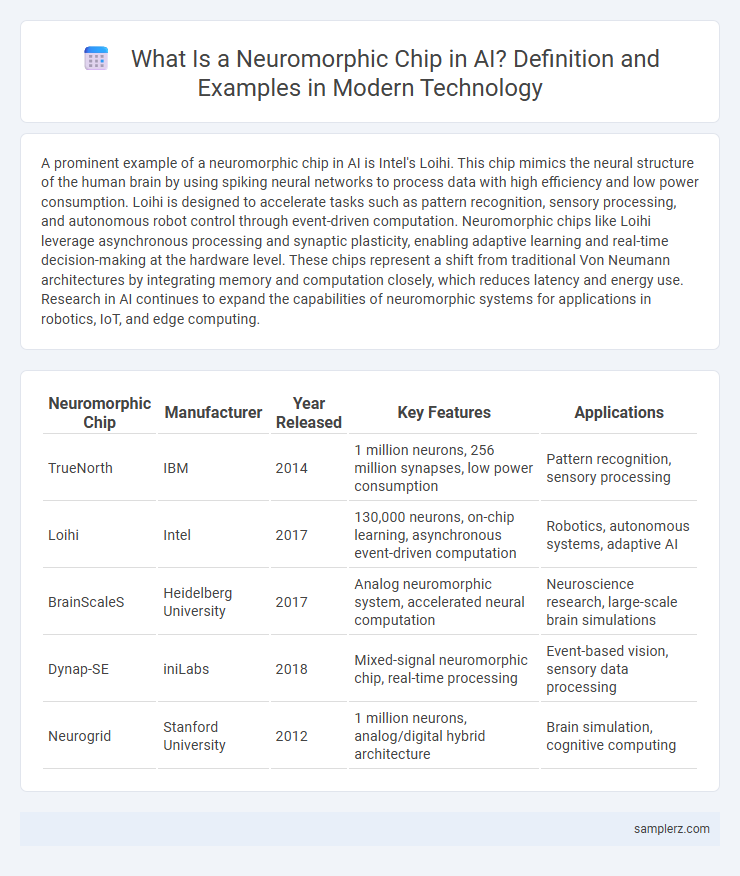A prominent example of a neuromorphic chip in AI is Intel's Loihi. This chip mimics the neural structure of the human brain by using spiking neural networks to process data with high efficiency and low power consumption. Loihi is designed to accelerate tasks such as pattern recognition, sensory processing, and autonomous robot control through event-driven computation. Neuromorphic chips like Loihi leverage asynchronous processing and synaptic plasticity, enabling adaptive learning and real-time decision-making at the hardware level. These chips represent a shift from traditional Von Neumann architectures by integrating memory and computation closely, which reduces latency and energy use. Research in AI continues to expand the capabilities of neuromorphic systems for applications in robotics, IoT, and edge computing.
Table of Comparison
| Neuromorphic Chip | Manufacturer | Year Released | Key Features | Applications |
|---|---|---|---|---|
| TrueNorth | IBM | 2014 | 1 million neurons, 256 million synapses, low power consumption | Pattern recognition, sensory processing |
| Loihi | Intel | 2017 | 130,000 neurons, on-chip learning, asynchronous event-driven computation | Robotics, autonomous systems, adaptive AI |
| BrainScaleS | Heidelberg University | 2017 | Analog neuromorphic system, accelerated neural computation | Neuroscience research, large-scale brain simulations |
| Dynap-SE | iniLabs | 2018 | Mixed-signal neuromorphic chip, real-time processing | Event-based vision, sensory data processing |
| Neurogrid | Stanford University | 2012 | 1 million neurons, analog/digital hybrid architecture | Brain simulation, cognitive computing |
Introduction to Neuromorphic Chips in AI
Neuromorphic chips mimic the human brain's neural architecture to enhance AI processing efficiency and speed, exemplified by Intel's Loihi chip. This chip utilizes spiking neural networks to perform complex computations with significantly lower power consumption compared to traditional processors. By replicating synaptic behaviors, neuromorphic chips enable real-time learning and adaptive capabilities critical for advanced AI applications.
Key Features of Neuromorphic Hardware
Neuromorphic chips, such as Intel's Loihi and IBM's TrueNorth, mimic the brain's neural architecture to enable energy-efficient and real-time processing in AI applications. Key features of neuromorphic hardware include spiking neural networks, asynchronous event-driven computation, and on-chip learning capabilities that reduce power consumption compared to traditional processors. These chips excel in pattern recognition, sensory data processing, and adaptive learning, making them ideal for edge AI devices and robotics.
IBM TrueNorth: Pioneering Neuromorphic Processors
IBM TrueNorth exemplifies neuromorphic processors by mimicking the human brain's architecture with 1 million programmable neurons and 256 million synapses, enabling energy-efficient and parallel computing. This chip operates at a fraction of the power used by traditional processors, achieving 70 milliwatts for complex AI tasks. TrueNorth's architecture supports real-time pattern recognition, making it ideal for applications like sensory processing and autonomous systems.
Intel Loihi: Advancements in Neuromorphic Computing
Intel Loihi represents a significant breakthrough in neuromorphic computing, utilizing spiking neural networks to mimic brain-like processing with high efficiency and low power consumption. This innovative chip accelerates AI applications by enabling real-time learning and adaptive behavior, making it ideal for robotics, autonomous systems, and edge computing. Intel Loihi's architecture leverages asynchronous event-driven processing, which drastically reduces latency and enhances scalability compared to traditional neural network models.
BrainChip Akida: Edge AI Neuromorphic Solution
BrainChip Akida is a leading neuromorphic chip designed for edge AI applications, mimicking the human brain's spiking neural networks to process data efficiently with low power consumption. Its architecture enables real-time learning and pattern recognition, making it ideal for smart sensors, robotics, and IoT devices. The Akida chip's event-driven processing significantly reduces latency compared to traditional AI processors, enhancing performance in energy-constrained environments.
SpiNNaker Project: Large-Scale Neural Emulation
The SpiNNaker project exemplifies advanced neuromorphic computing by simulating one million neurons in real time, enabling large-scale neural emulation for AI research. Its architecture mimics the parallel processing capabilities of the human brain, significantly improving efficiency in machine learning and cognitive computing tasks. This technology accelerates development in brain-inspired AI models, fostering breakthroughs in neural network design and artificial intelligence applications.
Tianjic Chip: Bridging Neuroscience and AI
The Tianjic Chip exemplifies neuromorphic technology by integrating spiking neural networks with traditional AI architectures to mimic human brain functionality. Its hybrid design accelerates cognitive computing tasks while reducing energy consumption compared to conventional silicon-based processors. This innovation bridges neuroscience and AI, enabling more efficient, brain-inspired machine learning applications.
HRL Laboratories’ Analog Neuromorphic Chips
HRL Laboratories' Analog Neuromorphic Chips exemplify advanced AI hardware designed to mimic the neural architecture of the human brain for improved computational efficiency. These chips utilize analog circuits to process information in a parallel and event-driven manner, significantly reducing power consumption without compromising performance. By enabling real-time sensory data processing, HRL's neuromorphic technology enhances machine learning applications within robotics and autonomous systems.
Applications of Neuromorphic Chips in Robotics
Neuromorphic chips, such as IBM's TrueNorth and Intel's Loihi, revolutionize robotics by enabling energy-efficient, real-time sensory processing and autonomous decision-making. These chips mimic neural architectures, allowing robots to perform complex tasks like adaptive navigation, object recognition, and motor control with enhanced speed and reduced power consumption. Their integration accelerates advancements in autonomous drones, robotic prosthetics, and intelligent industrial automation systems.
Future Trends in Neuromorphic AI Technologies
Intel's Loihi 2 neuromorphic chip pioneers future trends in AI by emulating human brain neurons and synapses to enable low-power, real-time learning and adaptation. This chip supports scalable architectures ideal for edge computing in autonomous vehicles and robotics, showcasing advancements in energy-efficient AI processing. Emerging neuromorphic technologies forecast integration with quantum computing and advanced sensor fusion to revolutionize intelligent systems.

example of neuromorphic chip in AI Infographic
 samplerz.com
samplerz.com